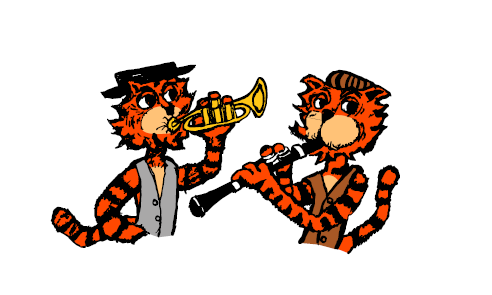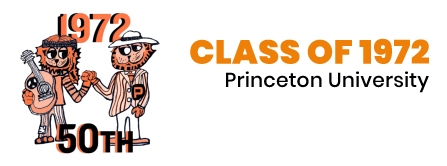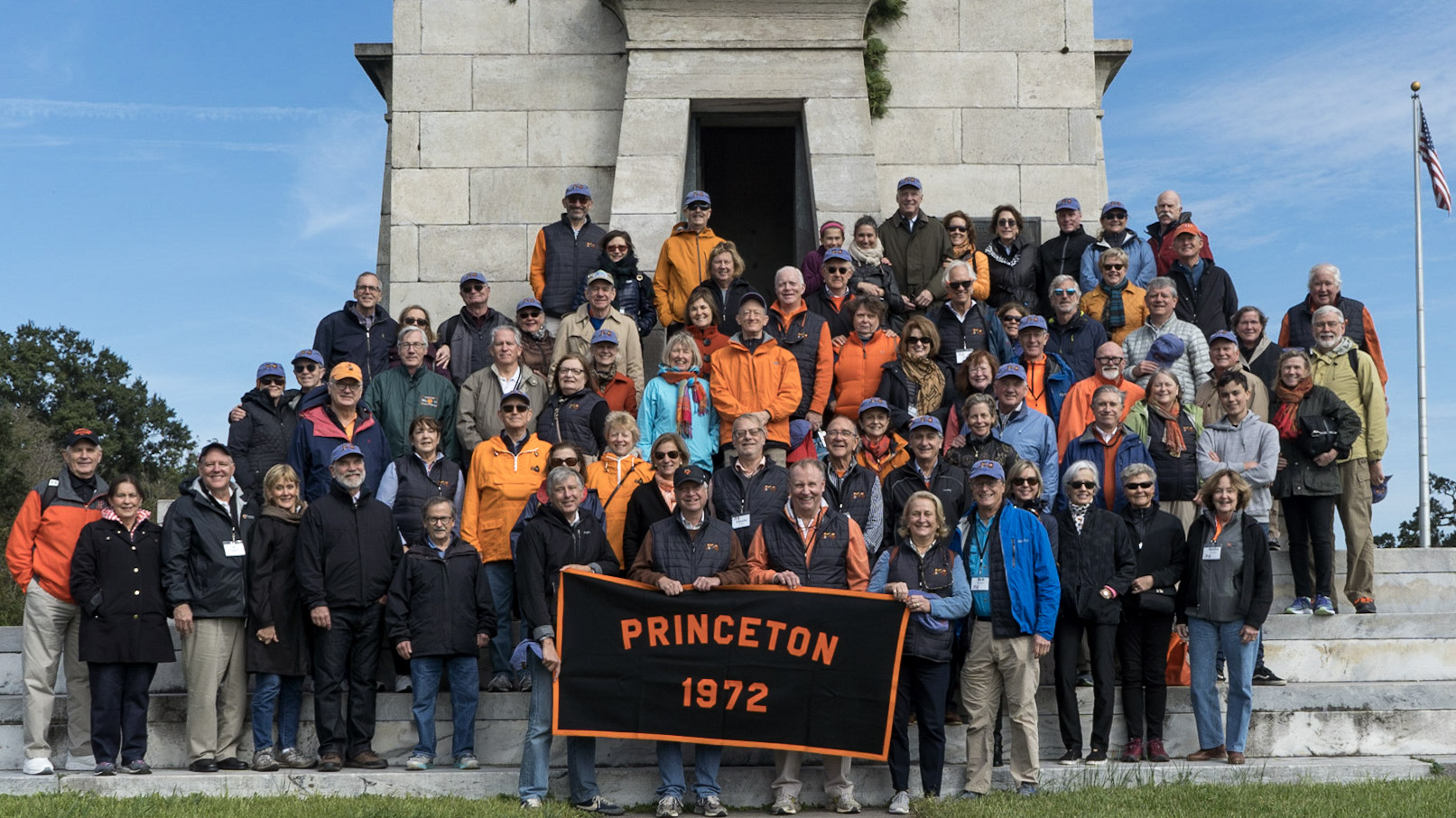 |
New Orleans 2018 On Wednesday, November 7, 89 class members and guests checked in to the Maison Dupuy Hotel in the French Quarter of old New Orleans. This was one of the largest assemblages of classmates on our trips. We were also joined by Professor Sean Wilentz (and family) of the History Department at Princeton University. We were treated to a buffet dinner as we arrived, offsetting the meager offerings of the airlines and preparing us for four days of intense sightseeing. After dinner the group assembled in our second-floor hospitality suite where beverages were enjoyed and all had the opportunity to reconnect with classmates and spouses, some of whom hadn't been seen in many years. As on the succeeding nights, most stayed up and partied well beyond the normal bedtimes for people of our advanced age. Robby failed to recognize the limitations of the old folks and scheduled the bus to leave at 7:45 the next morning. Any breakfast had to precede that early hour. The bus took us across town, past the recently vacated Lee Column, to the burgeoning World War II Museum in what used to be the city’s warehouse district. There we were treated to a private viewing of the multi-media projection “Beyond All Boundaries” with the voice of Tom Hanks offering a short but graphic history of the war, emphasizing the great tolls in lives and property that were exacted. We then heard remarks from museum staff who touched on the role Princeton played in the great conflict. After the talks, the group was free to view as many exhibits as they could in the next three hours. These included the pre-war situation and conditions, a complete museum on D-Day, and entire floors covering the Atlantic and Pacific theaters. Most enjoyed the museum thoroughly although a few were heard to be so overwhelmed by the death and destruction they couldn't go on. There was suggestion that Class Historian Ed Strauss try to follow his translated World War I memoir, “Poilu”, with a similar book for the Second World War so we could better understand the participants in this conflict. The Museum brilliantly showcases the finest American accounts of this conflict, in the words of William Manchester, Edward R. Murrow, Ernie Pyle, and Eugene Sledge and many more. Lunch had a surprise in store for us. We were entertained by the Victory Belles, a trio of lovely ladies who sang popular songs from the forties. As they crooned, a couple of the singers came down into the crowd to initiate some audience participation. Sandy Bieber was selected as the target of their love interest. Then Doug Harrison and Larry Kurtz were required to dance badly with members of the trio. Everyone had a great laugh. There are even some surreptitious recordings of the goings on which Doug will endeavor to erase. Finally the troupe finished with a medley of patriotic themes for the US armed forces, honoring the veterans in our group: Ray Dubois, Bob Meany, and Don Pyle. After a short break we reconvened in the Malcolm Forbes '41 Theater. There we were treated to a lecture by Professor Sean Wilentz, who focused on Reconstruction after the Civil War in New Orleans. We learned of the different rules regarding slavery in Louisiana before the war which resulted in a very unusual population with nearly as many free blacks as whites within New Orleans before the war. The Professor concentrated on an 1866 massacre perpetrated by the New Orleans Police (mostly Confederate veterans) against delegates to the state's constitutional convention and free black veterans in the city. This event was to change the course of Reconstruction and the Andrew Johnson presidency when it was publicized in the North. The controversy reaches right up to the present day, with the recent removal of monuments of that turbulent era. A lively and far-reaching Question and Answer session followed Professor Wilentz's remarks. That night the group collected on the buses to travel to the world-renowned Commander's Palace Restaurant in the Garden District of New Orleans. We filled a large room for a five- course meal. The first course was a little slow in coming so the group made up for the delay with copious quantities of wines. Luckily no one was driving home. The meal was spectacular with New Orleans specialties capped off by a sous-vide filet with a French sauce. If we were slow because of the early start on Thursday, we were even slower on Friday due to the wine the night before. We split into two groups to tour the French Quarter and the Garden District. These walking tours took place in a steady rain and the group showed perseverance and pluck by continuing to walk as we became soaked through and through. In the Garden District we saw numerous multi-million dollar houses, many owned by celebrities (football’s Manning family) and one which was the site of reverse-aging of Benjamin Button. We also heard the story of the New Orleans Cemeteries with their above-ground tombs built to avoid the problem of floating caskets in floods. The group reunited at Deanie's (not Denny's) where we ate the traditional New Orleans lunch, the Po' Boy, the local style of hoagie-hero. We had the privilege of dining with Princeton's original Hoagie Man, Charley Kohl. The tour of the French Quarter concentrated on history and the sourcing of common phrases in use everywhere today (“get the shaft” or “skeleton key” as examples). The French Quarter was the original section of the city, founded in 1718, and sits on the high ground a mere 15 feet below sea level. We repaired to the Cafe Du Monde where we drank coffee with chicory and enjoyed New Orleans health food, the Beignet, a fried pastry covered with sugar. Friday evening, we split into smaller groups to dine at three famous New Orleans restaurants: Arnaud's, Brennan's, and Galatoire's. We were much better behaved than the previous night and there was only moderate insobriety. The groups compared legends perpetrated by our various guides during the day and found that there was a great deal of variation in the local legends and ghost stories as related by the guides. Saturday we gathered on a riverboat, the Creole Queen, for a cruise down the Mighty Mississip’ serenaded by Johnny Horton's hit 1959 song about the Battle of New Orleans.
We debarked in Chalmette, the site of the battle. We learned from the park ranger that although the battle was fought after the War of 1812 armistice, the middle of the US would have been ceded to the British if conquered before the ratification of the Treaty of Ghent by the warring parties. Our St Louis contingent -- Dotty and Dave Kemper, Anne and Phil Shinn -- might have spoken with a different accent if Andrew Jackson had not won the battle. Following lunch on the riverboat, the contingent crossed the river and headed for the swamps for the heralded Jean Lafitte Swamp Tour. We boarded tour boats and learned from our Cajun commentator about big gators, who'd just as soon eat you, small gators who had to hide from the big ones, and mama gators who are known to be aggressive with visitors from the North. No one leaned too far out over the rails or dragged their fingers through the water. On the way back to the dock, everyone handled a baby gator. (His mouth was taped shut to protect our fingers.) Here's the proof (Courtesy of Barbara Julius) During the tour, a number of phones were tuned to the Princeton-Yale football game in which Yale was appropriately thrashed. The climax of the trip took place on Saturday night when we visited classmate Janet Reyering Howard and Scott Howard's (a proud Yale graduate) Garden District home. Absolutely spectacular. 14 foot ceilings with Scott's art covering the walls. A great dinner was experienced by all. Following dinner after the requisite locomotives, the class sang a new composition by Owen Curtis and Kathy Ayers. The Bottle of New Orleans lyrics by Kathy Ayres & Owen Curtis PHOTOS ARE HERE. |
 |


